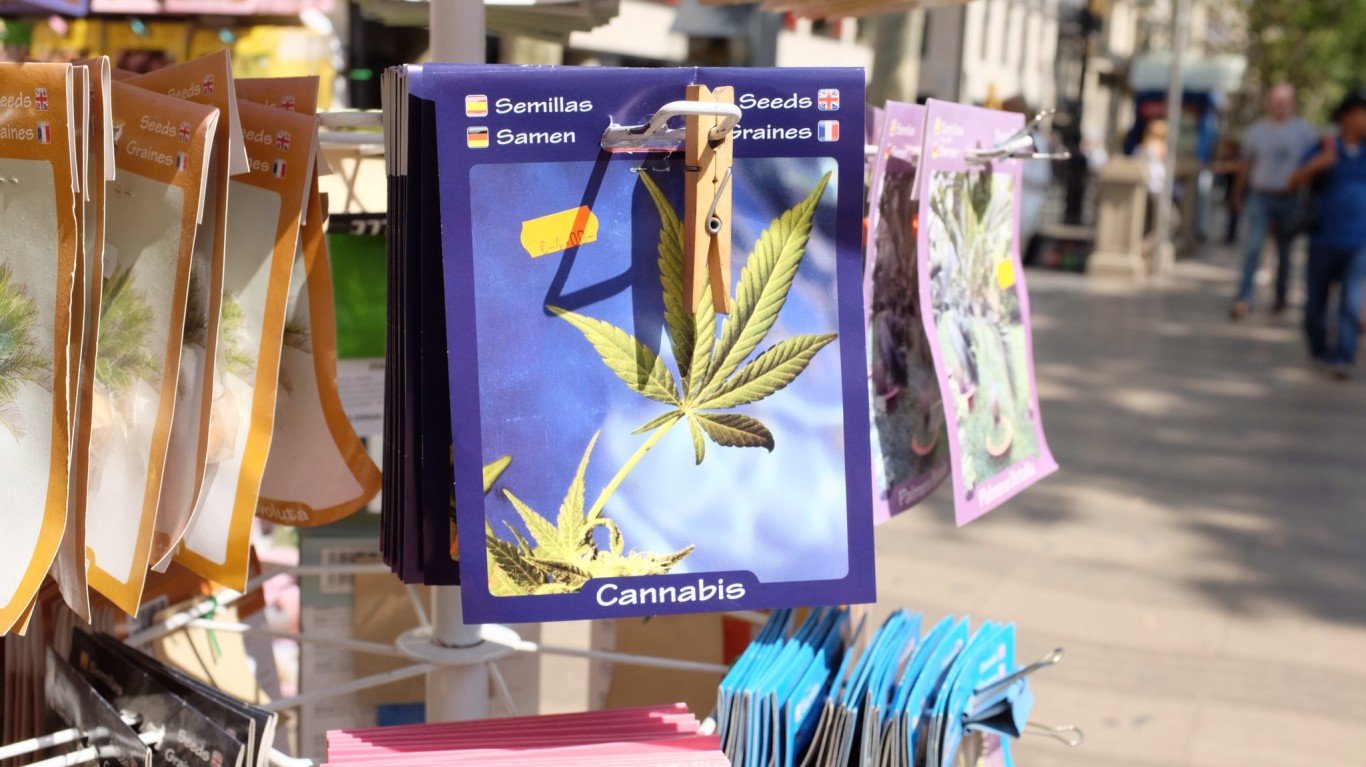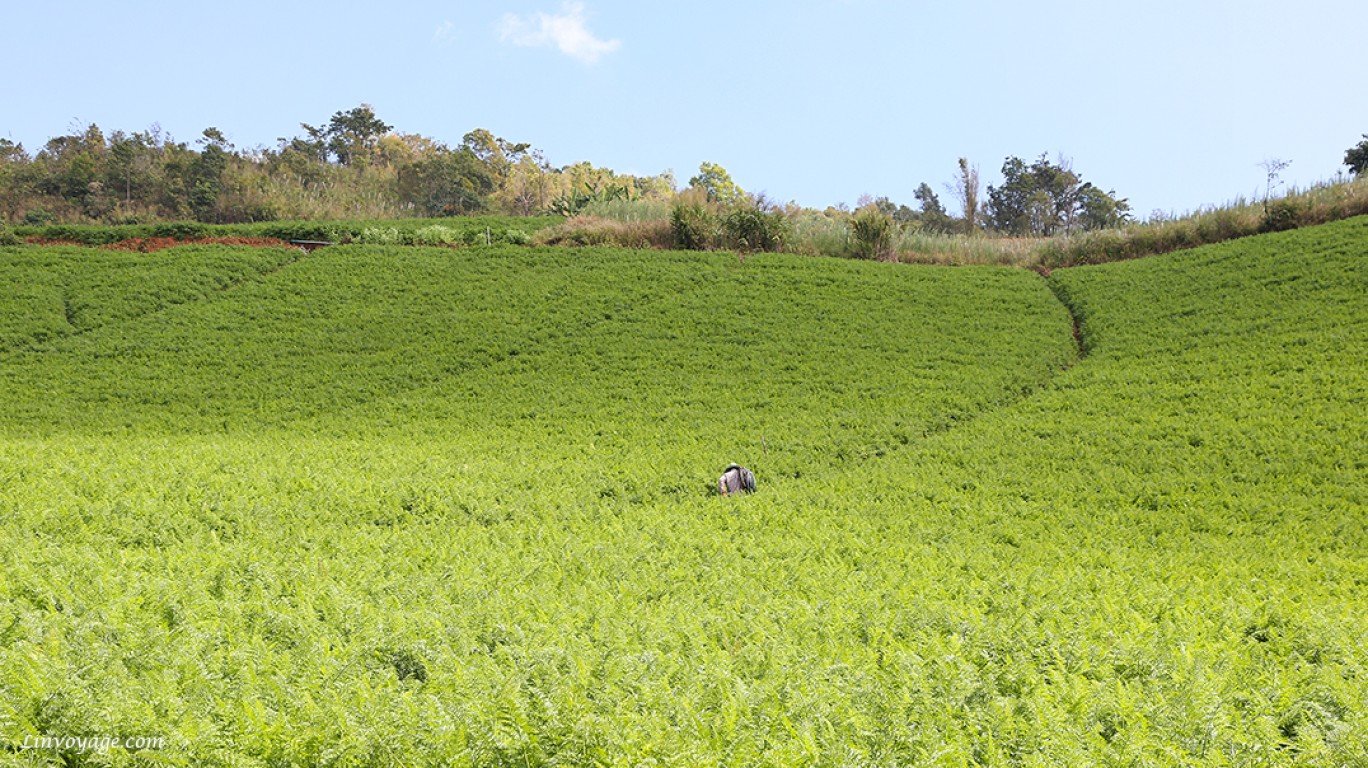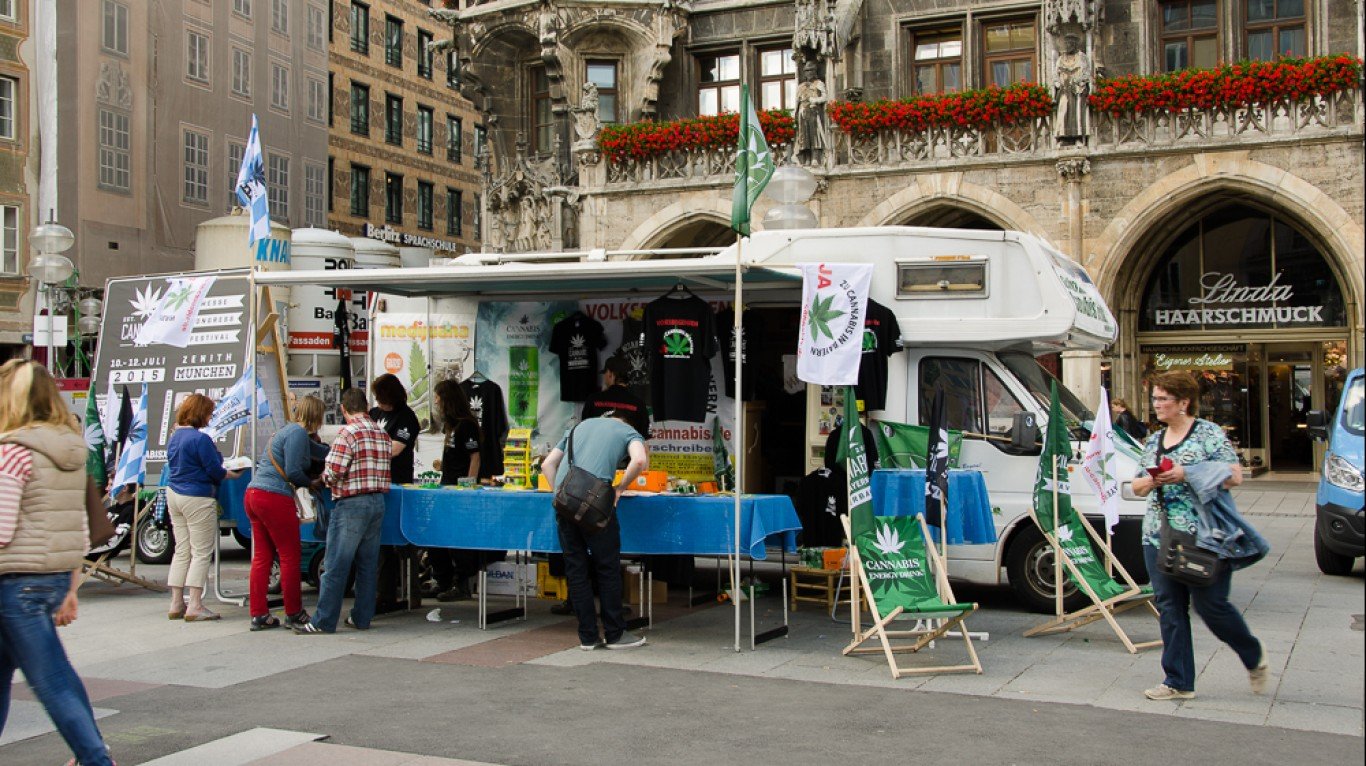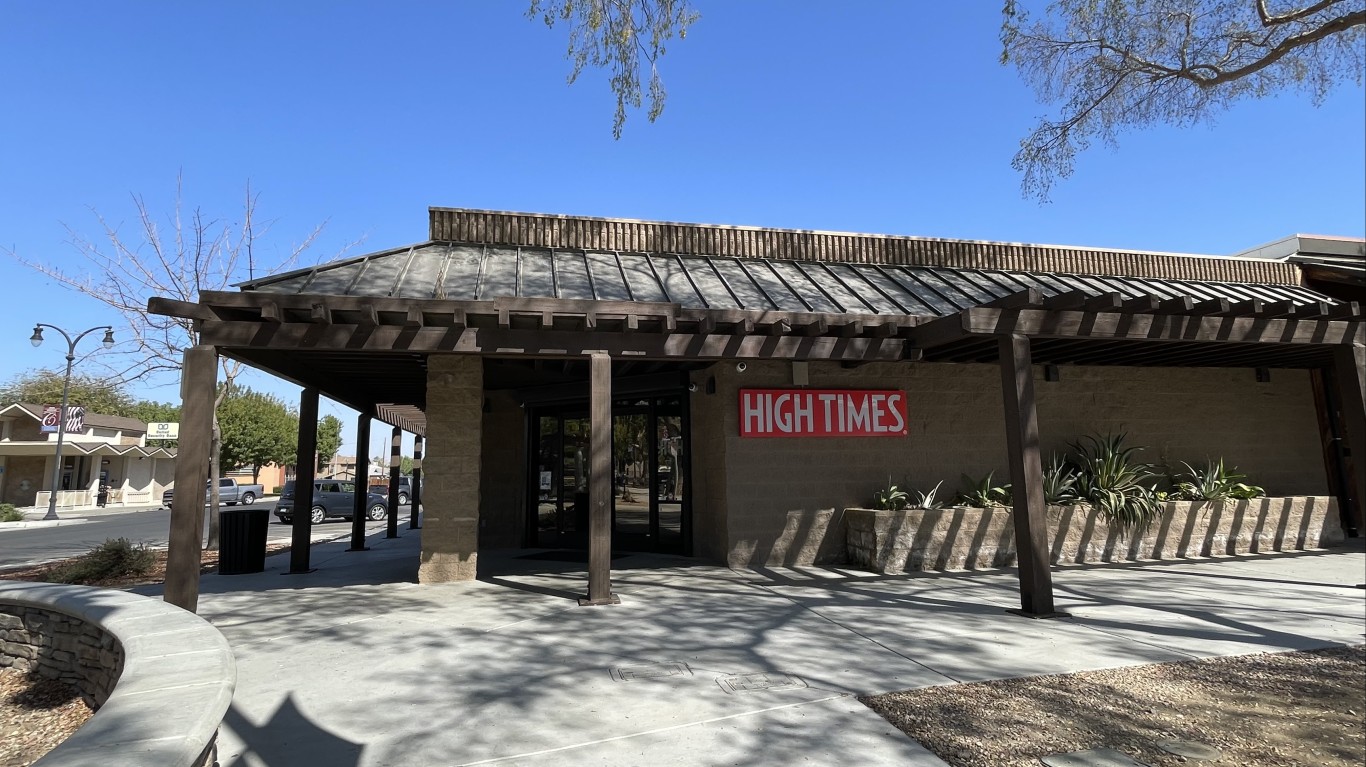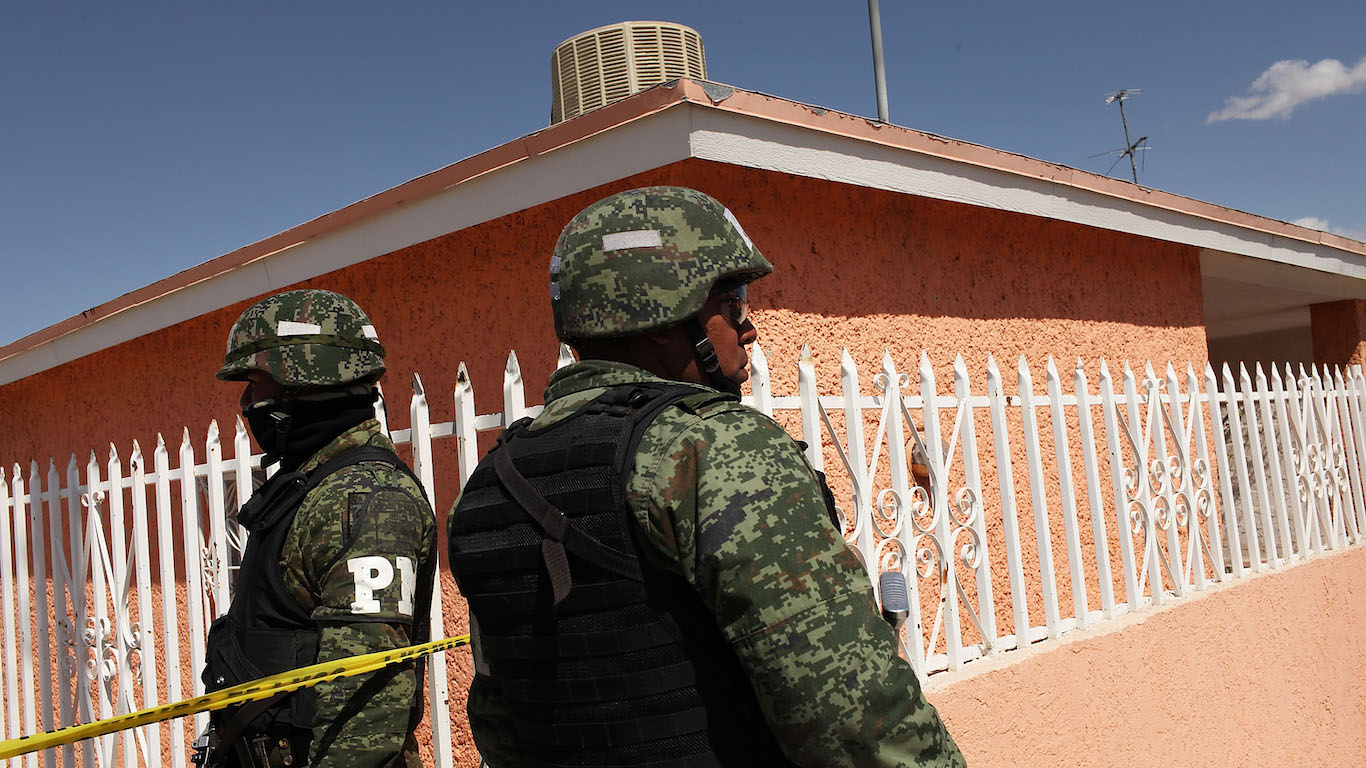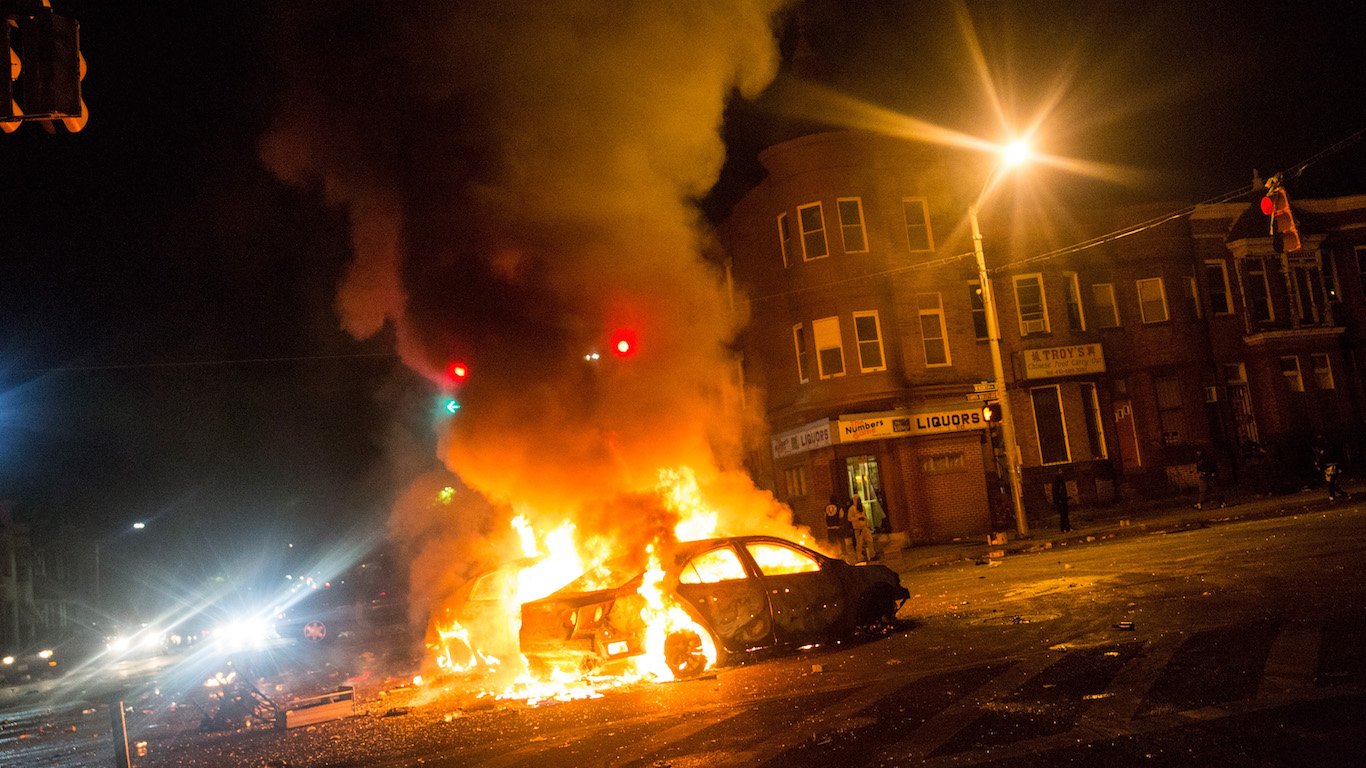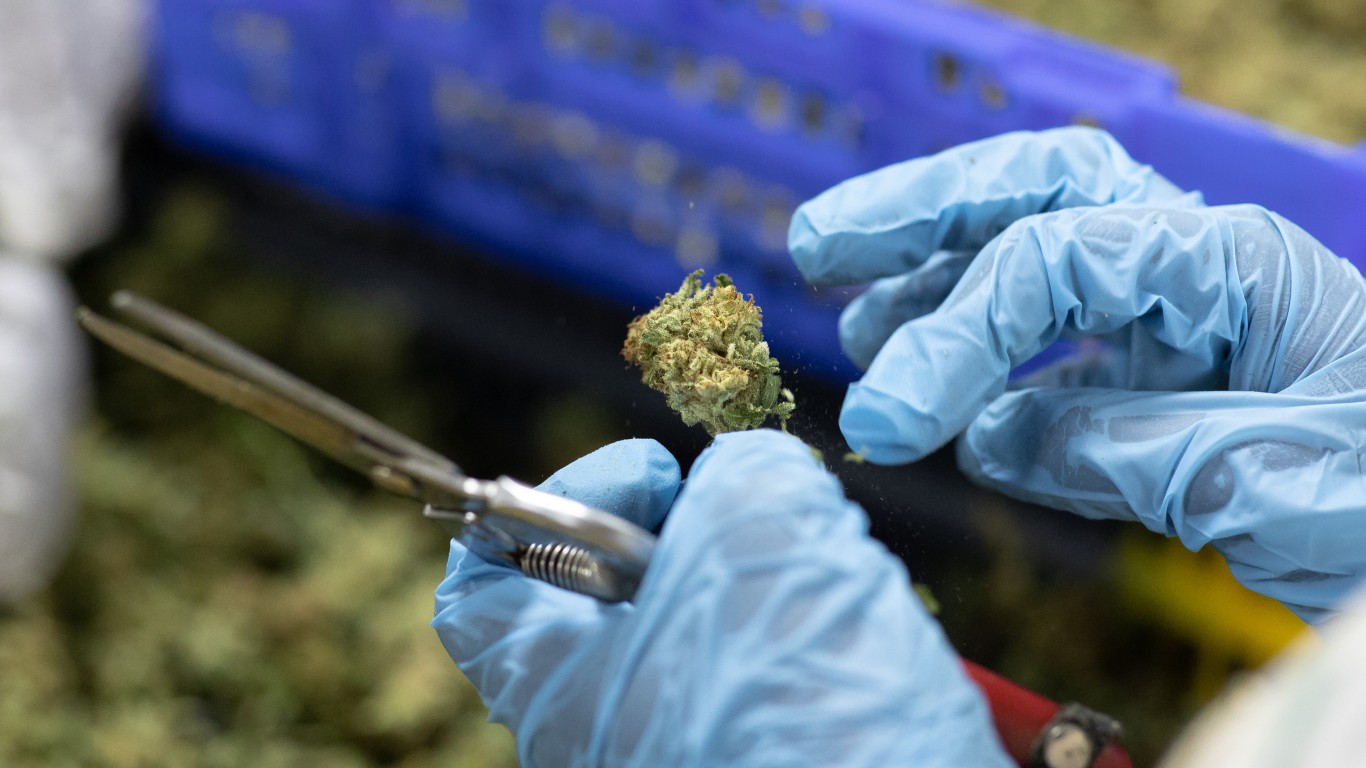

According to market and consumer data company Statista, revenue in the cannabis market is forecast to reach $47.2 billion this year. Most of that revenue, $32.9 billion, is projected to come from the United States. (Another industry governments are profiting from is guns. Here are the states where the government is profiting the most from gun sales.)
To identify the 20 countries with the biggest cannabis markets, 24/7 Wall St. reviewed Statisa’s estimated annual revenue from cannabis sales in 59 countries in 2022, using data published November 2022. Sales include retail sales and taxes, encompassing business to business as well as business to consumer transactions, using current exchange rates. Sales of medical, therapeutic, and recreational cannabis are included. All cannabis data came from Statista. Population and gross domestic product data for 2020 comes from the World Bank.
The cannabis market is divided into three segments: medical, therapeutic, and recreational. The medical and therapeutic areas have been legalized in more countries than recreational use. According to Statisa’s analysis, therapeutic cannabis use rose during the pandemic, as its use is perceived to help those cope with anxiety, even though research on the matter is limited and health professionals warn the effects are complex and not without risk. (One great way to improve mood is through exercise. Here are 30 reasons why walking is the best exercise.)
Some still look askance at cannabis as a recreational drug, fearing it leads to more powerful narcotics. Cannabis is fully or partially legal in all but six U.S. states. Because it is still considered a Schedule 1 drug by the U.S. federal government, however, banks are reluctant to lend to cannabis businesses because of the burden of compliance.
The maturity of the cannabis market varies by country because of differing legal environments and public attitudes toward the product. Even so, the outlook for cannabis is bullish. Legalization means higher tax revenue. The industry is introducing all manner of new products, and there is considerable merger and acquisition activity.
According to Statista, revenue from cannabis in the 20 nations on our list was forecast to rise more than 40% in 2022 from the previous year. In 16 countries, revenue was projected to leap more than 100% from 2022 to 2027.
Click here to see 20 countries where people buy the most marijuana.
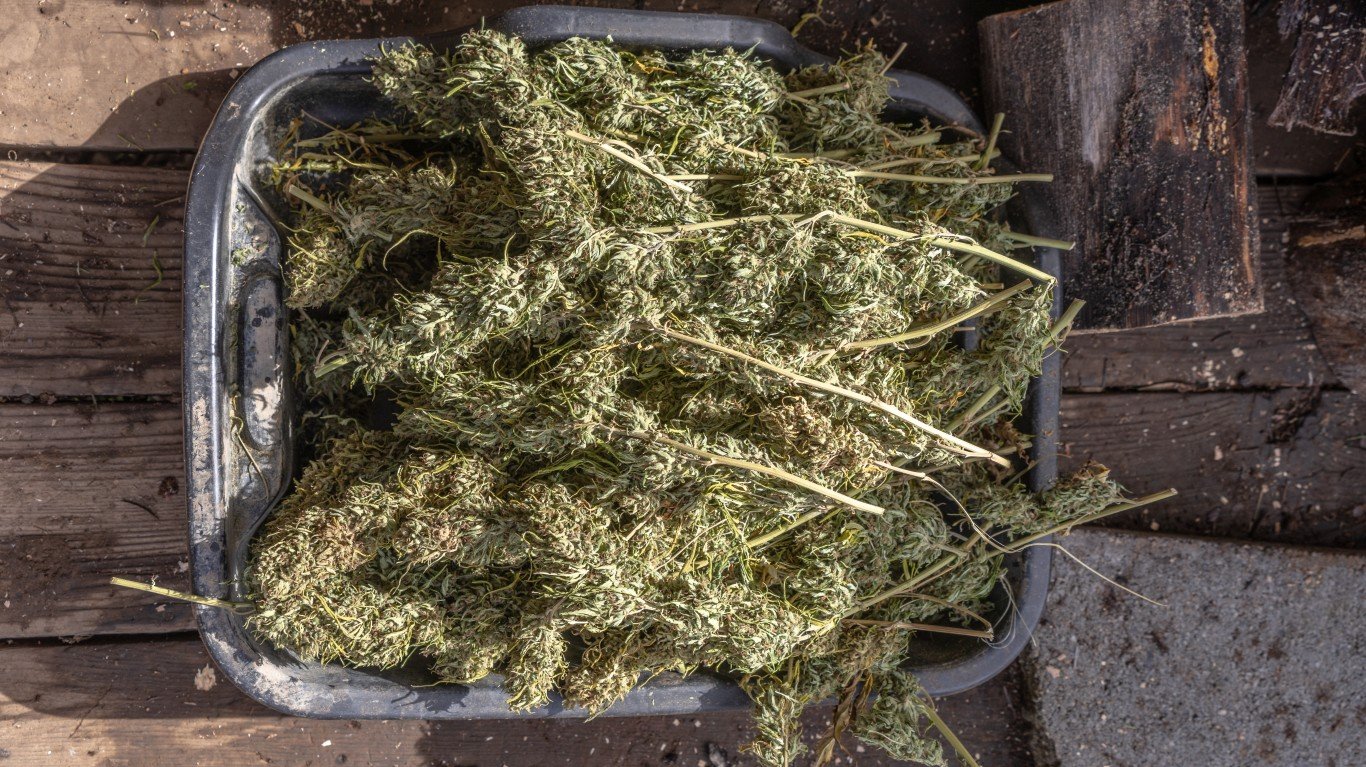
20. Mexico
> 2022 cannabis revenue: $106.3 million (+42.4% from ’21)
> 2021 cannabis revenue: $74.7 million
> 2021 population: 130,262,220
> 2021 GDP: $1.27 trillion
> 2027 projected cannabis revenue: $227.5 million (+114.0% from ’22)
Changes to Mexico’s cannabis laws in 2021 allowed for regulation of therapeutic and pharmacology uses of cannabis. In 2019, research and public opinion firm Consulta Mitofsky revealed that 58% of Mexicans surveyed accepted cannabis legalization. While technically cannabis is legal in Mexico following a Supreme Court decision that prohibition is unconstitutional, Mexico’s Congress has yet to pass a full legalization law.
[in-text-ad]
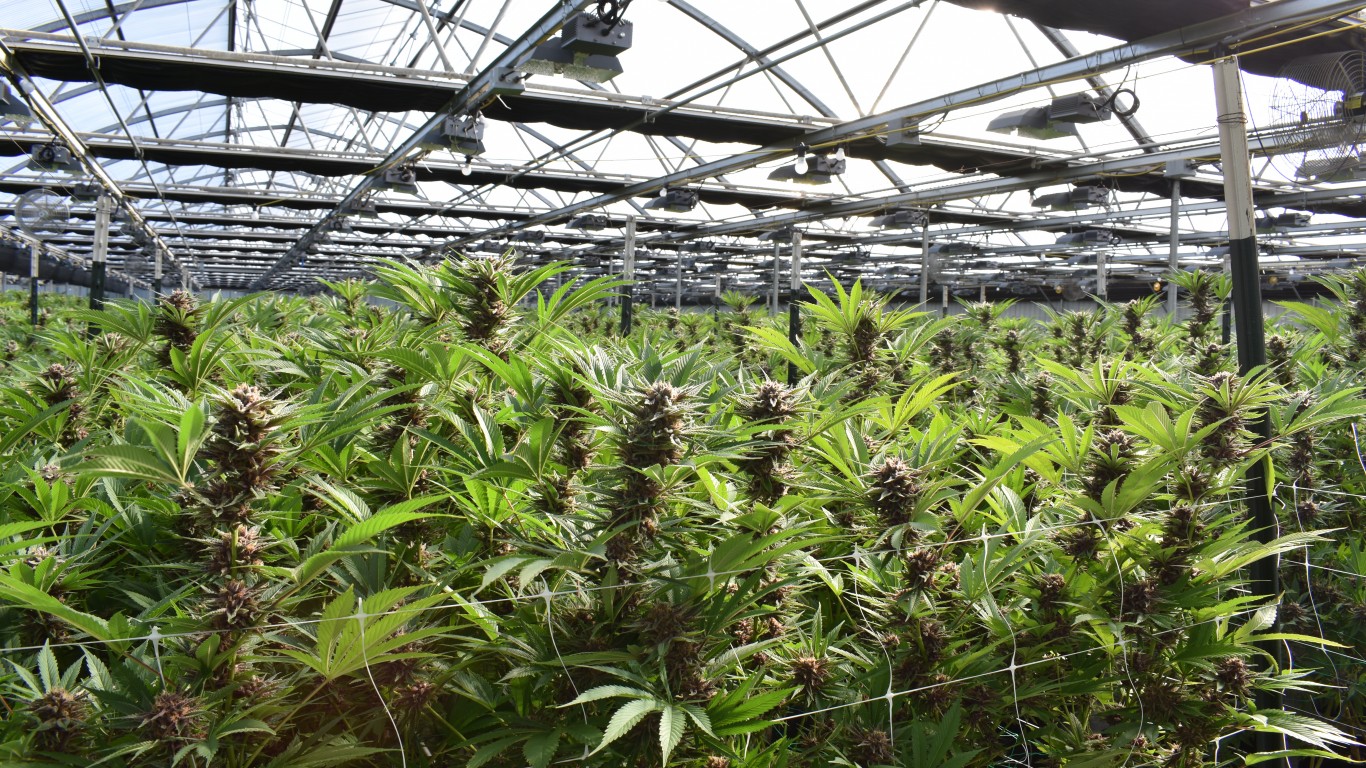
19. Norway
> 2022 cannabis revenue: $106.9 million (+42.0% from ’21)
> 2021 cannabis revenue: $75.3 million
> 2021 population: 5,408,320
> 2021 GDP: $482.17 billion
> 2027 projected cannabis revenue: $229.4 million (+114.6% from ’22)
Norway has not legalized recreational cannabis, though possession of less than 15 grams is usually punished with a fine, according to NORML Norway. “Since 2018, the Norwegian Medicines Agency allows doctors approved by the agency to prescribe medical cannabis for patients on a case-by-case basis,” according to The Cannigma.
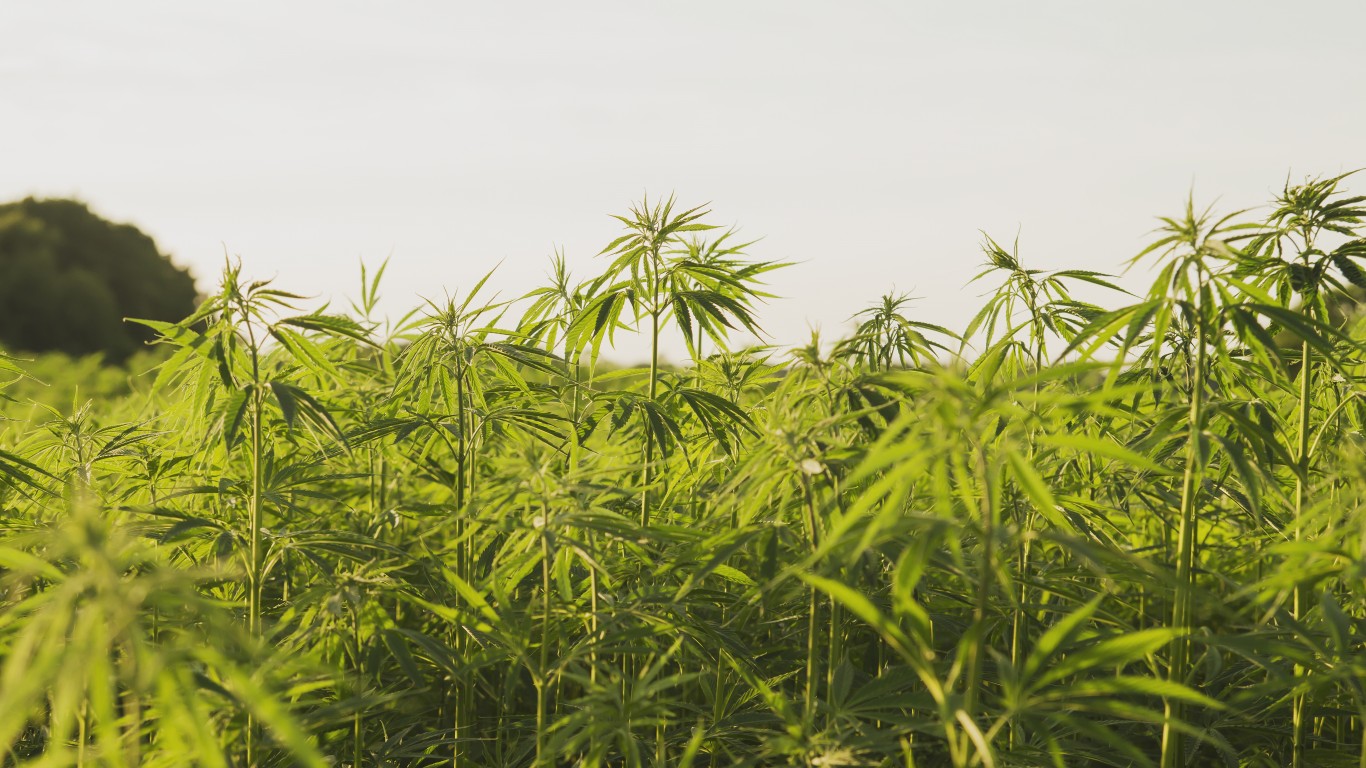
18. Belgium
> 2022 cannabis revenue: $108.1 million (+31.6% from ’21)
> 2021 cannabis revenue: $82.2 million
> 2021 population: 11,587,882
> 2021 GDP: $594.10 billion
> 2027 projected cannabis revenue: $225.0 million (+108.1% from ’22)
Recreational cannabis is not legal in Belgium, but enforcement is generally considered lax, according to The Cannigma. The site further states that possession of up to 3 grams by those over 18 is punishable by a fine. There are cannabis social clubs that use loopholes to operate, similar to cannabis clubs in Spain. Calls to fully legalize and regulate cannabis have been increasing in Belgium. The Western European country legalized medical marijuana in 2015. Belgium has a limited medical cannabis program that recognizes Sativex and CBD.
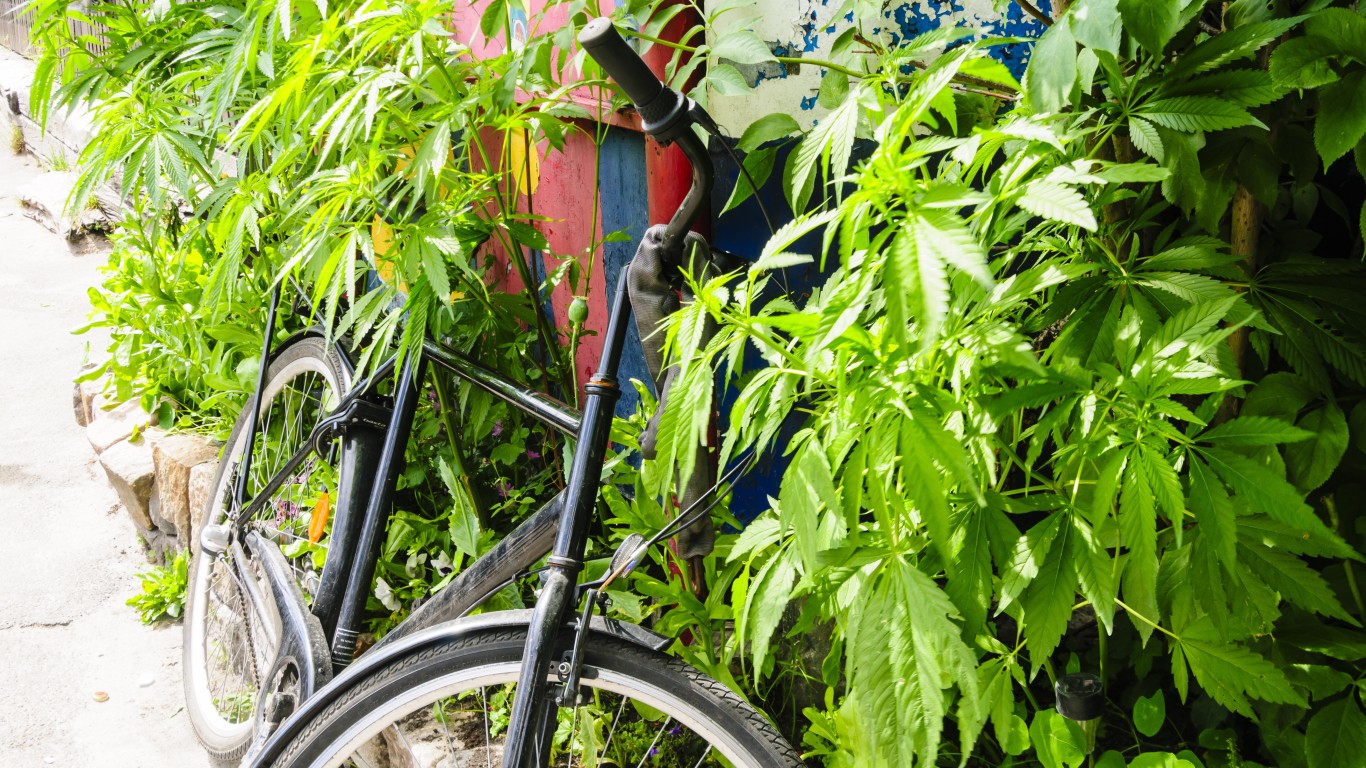
17. Denmark
> 2022 cannabis revenue: $110.6 million (+48.6% from ’21)
> 2021 cannabis revenue: $74.4 million
> 2021 population: 5,856,733
> 2021 GDP: $398.30 billion
> 2027 projected cannabis revenue: $225.8 million (+104.2% from ’22)
It is illegal to import, export, sell, purchase, deliver, receive, produce, and process cannabis in Denmark. The laws on recreational use of cannabis in Denmark are a bit vague. Personal use of the substance is not illegal, but following passage of the Consolidated Act on Controlled Substances in 2016, possession of cannabis in Denmark became illegal, according to Sensi Seed.
In January 2018, the Danish Medicines Agency established Denmark’s first medicinal cannabis program. This granted 12 companies the right to distribute herbal cannabis in Denmark, Sensi Seed notes. These companies are allowed to produce and dispense cannabis to approved doctors and pharmacies throughout the country.
[in-text-ad-2]
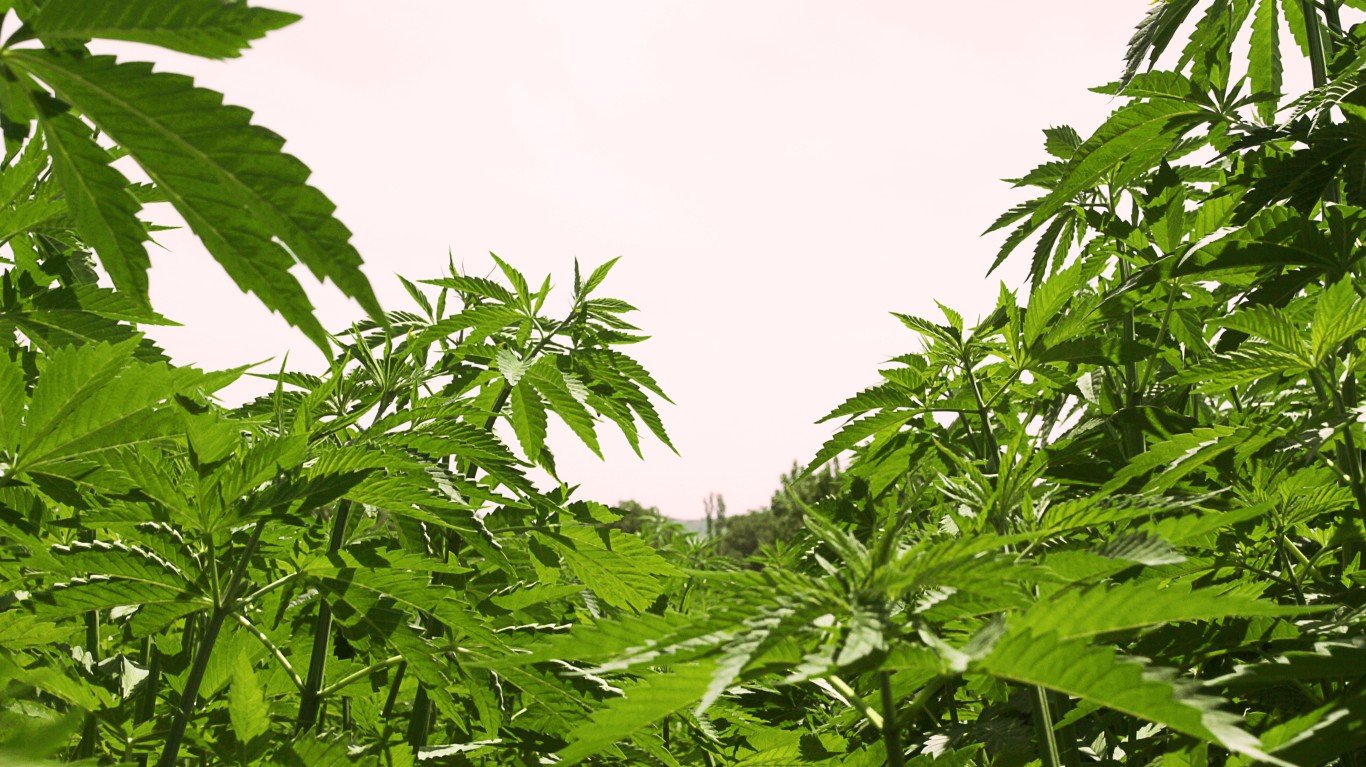
16. Türkiye
> 2022 cannabis revenue: $128.3 million (+36.1% from ’21)
> 2021 cannabis revenue: $94.3 million
> 2021 population: 85,042,736
> 2021 GDP: $819.04 billion
> 2027 projected cannabis revenue: $274.4 million (+113.9% from ’22)
Strict laws prohibiting narcotics were introduced in Türkiye in the 1970s. That changed somewhat in 2019, when Turkish President Recep Tayyip Erdogan called for a renewal of industrial hemp cultivation, citing its many benefits. About one-fourth of the nation’s 81 provinces allow marijuana to be cultivated for medicinal and scientific purposes. The guidelines regarding cultivation in Türkiye are strict.
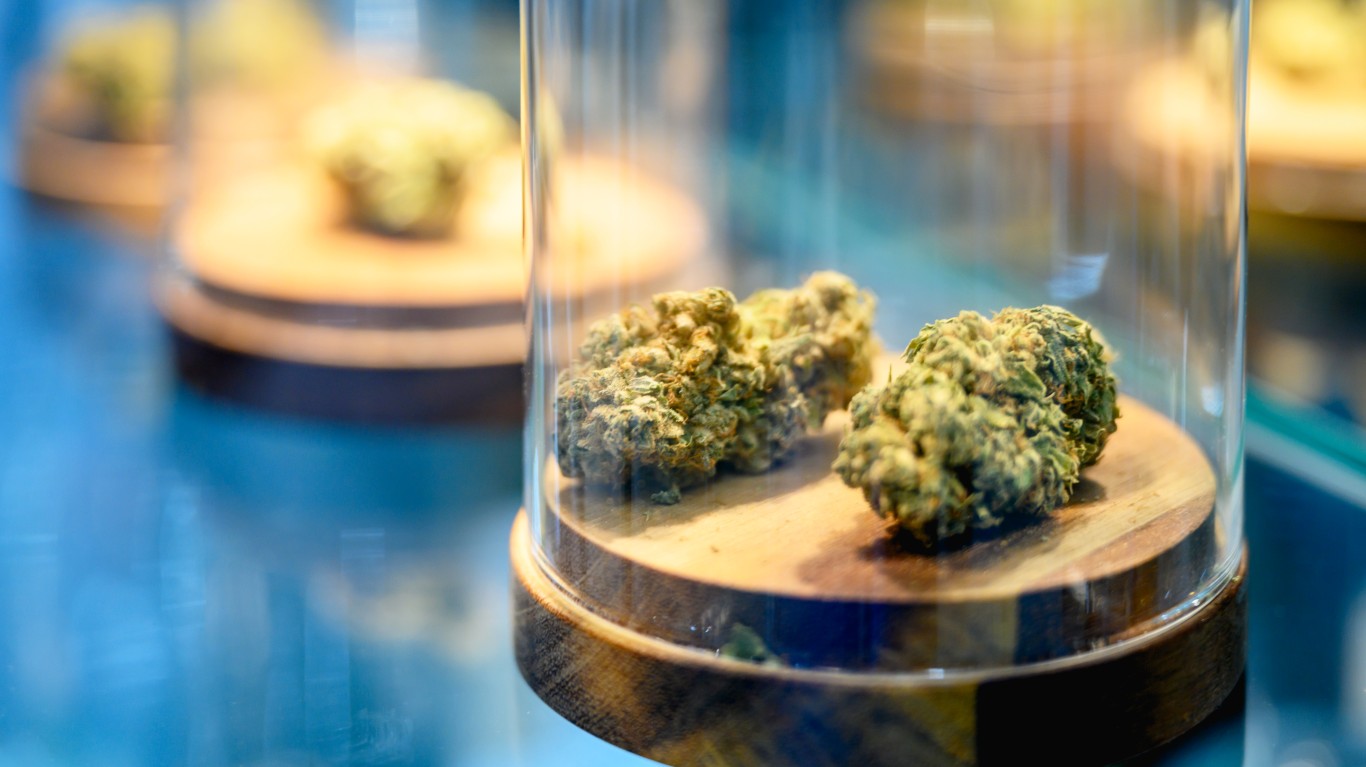
15. Poland
> 2022 cannabis revenue: $132.0 million (+42.0% from ’21)
> 2021 cannabis revenue: $92.9 million
> 2021 population: 37,781,024
> 2021 GDP: $679.44 billion
> 2027 projected cannabis revenue: $283.2 million (+114.5% from ’22)
Recreational cannabis is illegal in Poland. The Eastern European nation has harsh prohibition laws. Violating them can bring steep fines or long jail sentences, according to The Cannigma. Poland established a medical cannabis program in 2017, and cannabis products can be prescribed for various medical conditions. Poland does not have a catalog of illnesses, limits concerning patient age, nor gram amounts prescribed, so many Poles are able to get medical cannabis.
[in-text-ad]
14. Switzerland
> 2022 cannabis revenue: $140.1 million
> 2021 cannabis revenue: Not available
> 2021 population: 8,697,723
> 2021 GDP: $800.64 billion
> 2027 projected cannabis revenue: $286.2 million (+104.3% from ’22)
Switzerland legalized cannabis for medical purposes in 2022. It was reclassified from a “prohibited narcotic” to a “controlled substance.” Patients can get medical cannabis through a medical prescription. Before the new legislation, patients had to apply for a license to get cannabis as a medication. The legalization also allows the export of medical cannabis for commercial purposes.
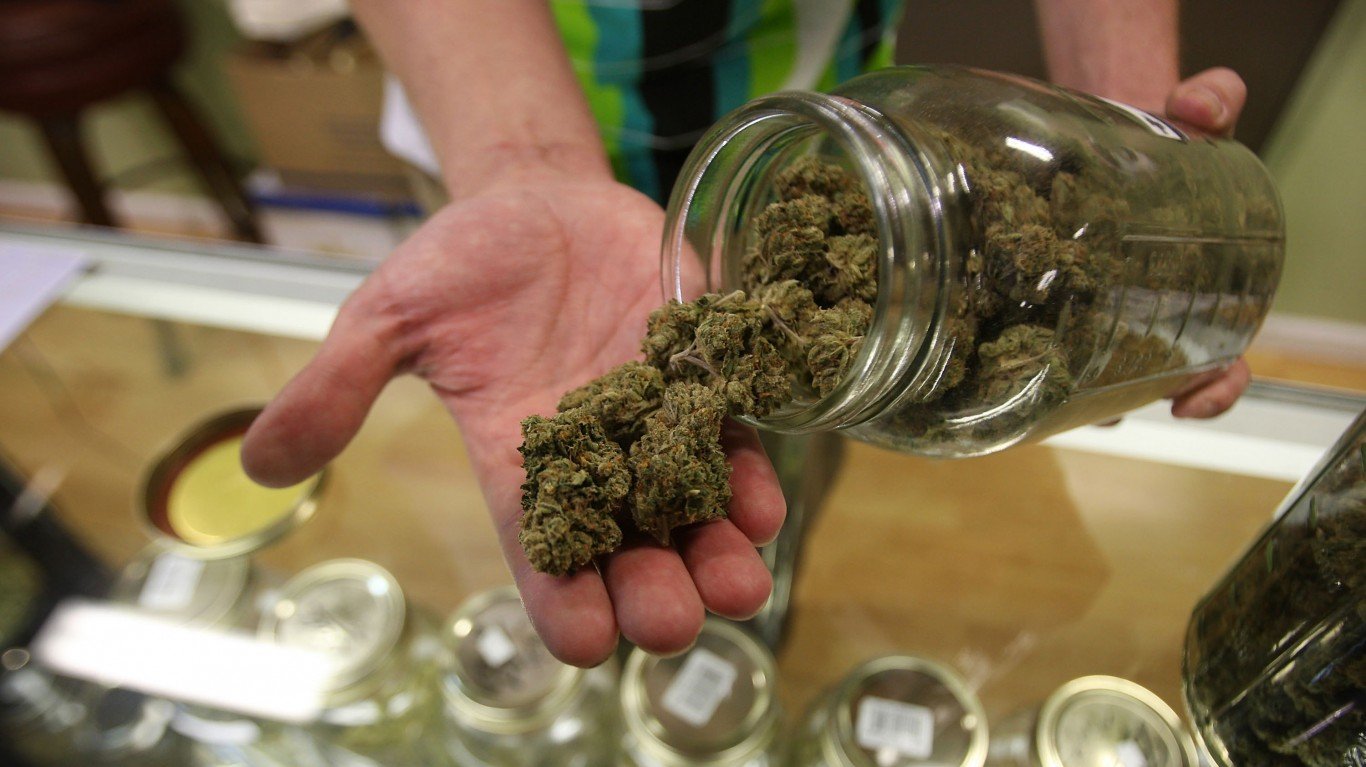
13. Brazil
> 2022 cannabis revenue: $151.2 million (+31.6% from ’21)
> 2021 cannabis revenue: $114.9 million
> 2021 population: 213,993,441
> 2021 GDP: $1.61 trillion
> 2027 projected cannabis revenue: $314.6 million (+108.1% from ’22)
Recreational use of cannabis is illegal in Brazil, but its use is widespread and is easily available. Even so, penalties are severe for using weed in Brazil. If caught, violators can be fined $500 to $1,500 and jailed for up to 15 years for selling, transporting, or trafficking marijuana. Possession and cultivation of cannabis in personal amounts and for private use was depenalized in Brazil in 2006, but judges have authority to decide whether a suspect is a dealer or a consumer. Cannabis-based medications are legal in Brazil for terminally ill patients.
Industry analysts see huge potential in the Brazilian market, the largest in South America, where many cannabis startups have sprung up in recent years. Around 80% of the population self-report to suffer from stress or anxiety, and cannabis is seen as an effective treatment, according to Prohibition Partners.
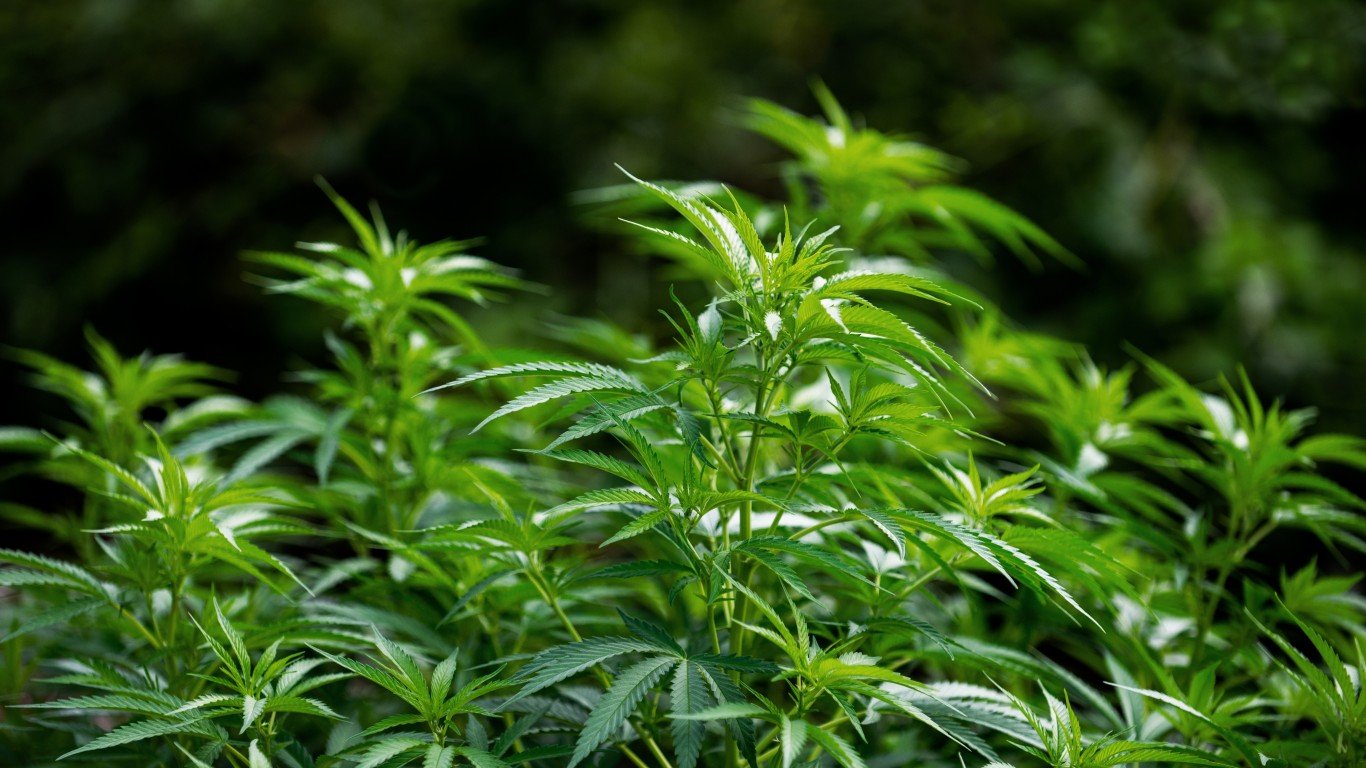
12. South Korea
> 2022 cannabis revenue: $221.7 million (+48.6% from ’21)
> 2021 cannabis revenue: $149.2 million
> 2021 population: 51,744,876
> 2021 GDP: $1.81 trillion
> 2027 projected cannabis revenue: $452.9 million (+104.3% from ’22)
Asian nations have some of the world’s harshest penalties for recreational use of cannabis, and South Korea is no different. Under its strict policies, trading and consumption of marijuana is illegal. Those who violate this law could face as much as five years in prison, according to Cannabis Place. South Korea even prosecutes its citizens for consuming cannabis in countries where recreational use is legal.
Cannabis was legalized in South Korea in November 2018 for medical purposes, allowing Korean citizens to use medicinal cannabis for extreme cases, such as epilepsy, cancer, and Parkinson’s disease.
[in-text-ad-2]
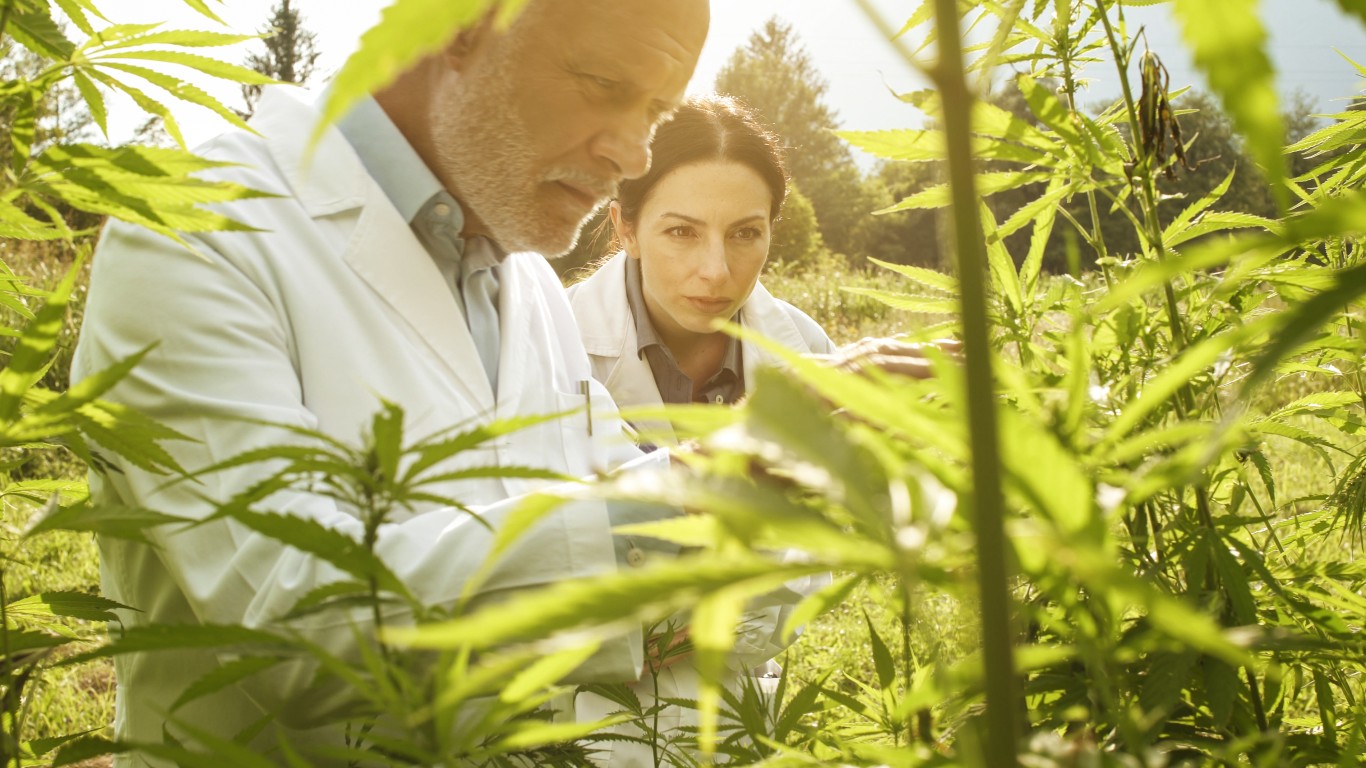
11. Italy
> 2022 cannabis revenue: $280.8 million (+25.0% from ’21)
> 2021 cannabis revenue: $224.6 million
> 2021 population: 59,066,225
> 2021 GDP: $2.11 trillion
> 2027 projected cannabis revenue: $546.1 million (+94.5% from ’22)
The possession or sale of cannabis in Italy is illegal and can be punished by confiscation of illegal documents such as driving license. Selling cannabis can carry a six-year prison sentence.
Since 2016, the cultivation of certain strains of hemp has been legal in Italy, as is medical use of cannabis and the use of CBD products. Cultivating a personal stash of medical marijuana in Italy is illegal. A survey found that 78% of Italians believe cannabis should be expanded for medical use.
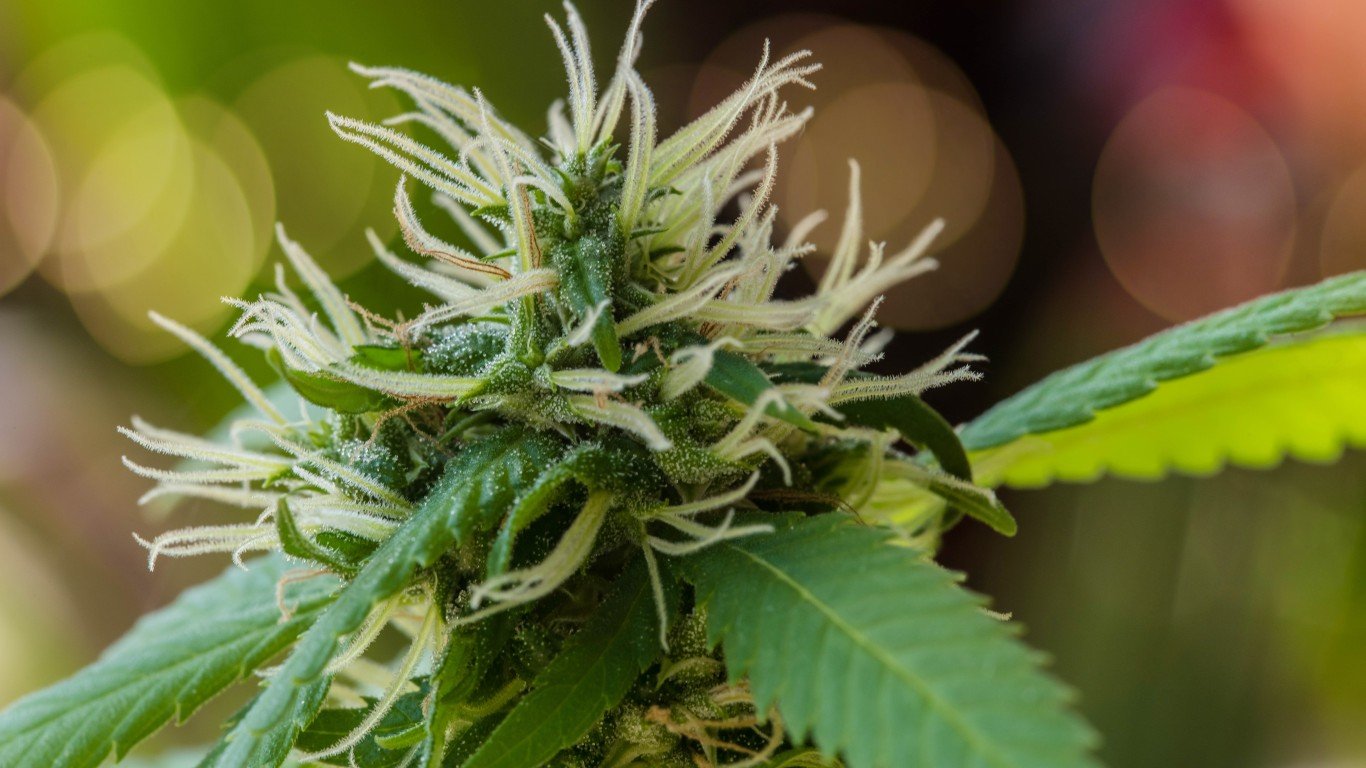
10. France
> 2022 cannabis revenue: $284.3 million (+25.0% from ’21)
> 2021 cannabis revenue: $227.4 million
> 2021 population: 67,499,343
> 2021 GDP: $2.96 trillion
> 2027 projected cannabis revenue: $552.8 million (+94.4% from ’22)
The French government issued a decree in February 2022 authorizing the cultivation of medical cannabis and the development of its industry. The legislation only specifies the conditions and procedures for the cultivation and production of cannabis for medical use and not its regulation. France has one of the strictest cannabis policies in the European Union, even though cannabis consumption is among the highest in Europe. Possessing cannabis can get a violator a prison sentence of up to one year and a fine of over $4,000.
[in-text-ad]
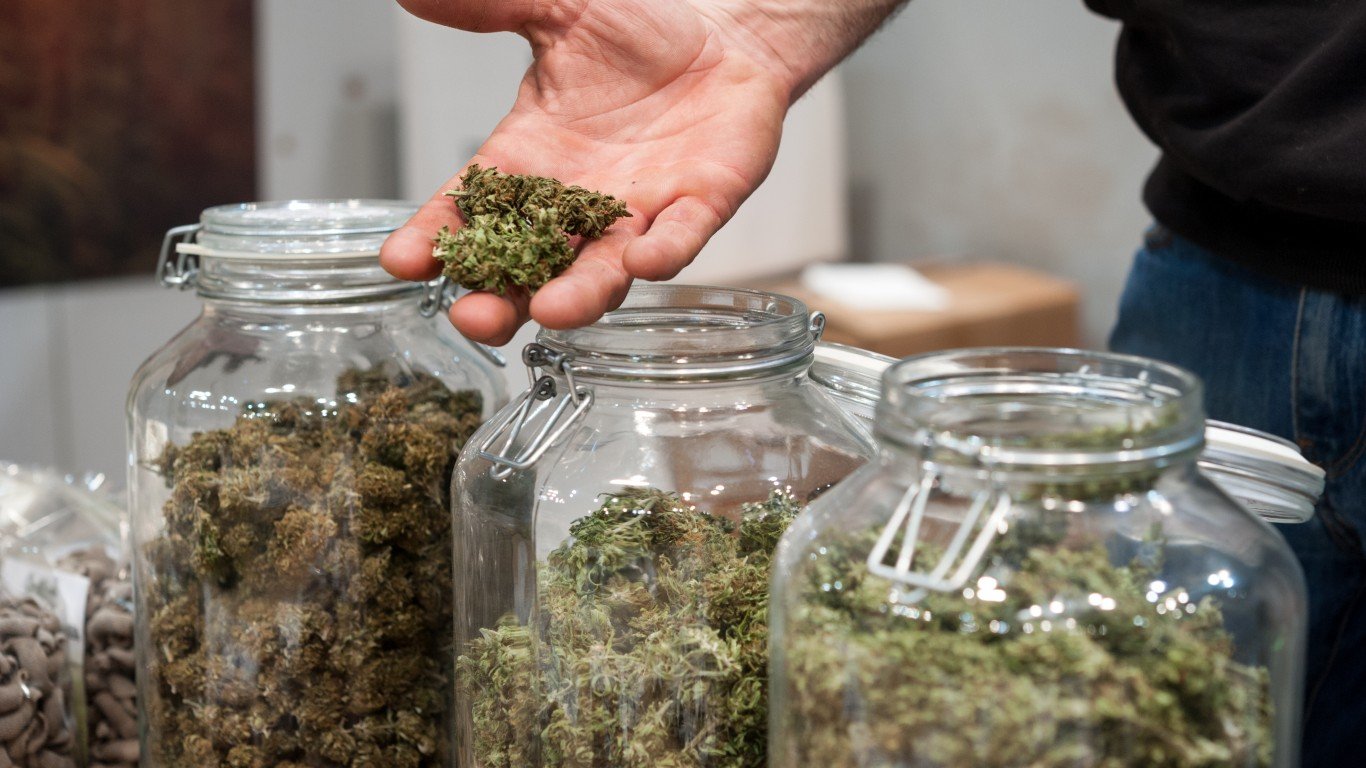
9. Australia
> 2022 cannabis revenue: $308.1 million (+36.1% from ’21)
> 2021 cannabis revenue: $226.4 million
> 2021 population: 25,739,256
> 2021 GDP: $1.55 trillion
> 2027 projected cannabis revenue: $659.1 million (+113.9% from ’22)
Australia legalized medical cannabis in 2016, but patients there have decried the program as too restrictive. Access to cannabis-based medicines remains behind that of many other legal cannabis jurisdictions. Recreational cannabis remains illegal on the federal level. The enforcement of cannabis laws and the penalties vary from one territory to another.
Cannabis is by far the most popular illicit drug in Australia. A survey published in July 2020 found that 41% of Australians support cannabis legalization, nearly double the level of support found in a 2007 survey (21%). A significant action toward legalization occurred in September 2019, when the Australian Capital Territory legalized cannabis possession up to 50 grams.

8. United Kingdom
> 2022 cannabis revenue: $346.4 million (+48.6% from ’21)
> 2021 cannabis revenue: $233.1 million
> 2021 population: 67,326,569
> 2021 GDP: $3.13 trillion
> 2027 projected cannabis revenue: $708.3 million (+104.5% from ’22)
The U.K. legalized medical cannabis in November 2018, but the program has been criticized because of lack of access to medicine and approval of patients. In 2004, the government reclassified cannabis to a Class C drug from a Class B, but the decision was rescinded five years later. Possession of a Class B drug carries a penalty of three months or a £2,500 fine and up to five years in prison. A 2018 poll found that 59% of British respondents back legalization.
7. Spain
> 2022 cannabis revenue: $652.8 million (+38.5% from ’21)
> 2021 cannabis revenue: $471.3 million
> 2021 population: 47,326,687
> 2021 GDP: $1.43 trillion
> 2027 projected cannabis revenue: $1348.0 million (+106.5% from ’22)
The cannabis laws in Spain are somewhat complicated. It is legal to buy seeds and growing equipment, but it is illegal to sell cannabis in Spain. Possession and consumption of cannabis are decriminalized, though it is not explicitly legal. Growing cannabis plants in visible places may result in fines. There are no legal penalties with possessing or smoking cannabis, but it cannot be smoked in public.
Spain has so-called cannabis clubs that operate under the loophole of private consumption. The nation on the Iberian Peninsula issues only a few licenses for medical and scientific cannabis research.
[in-text-ad-2]
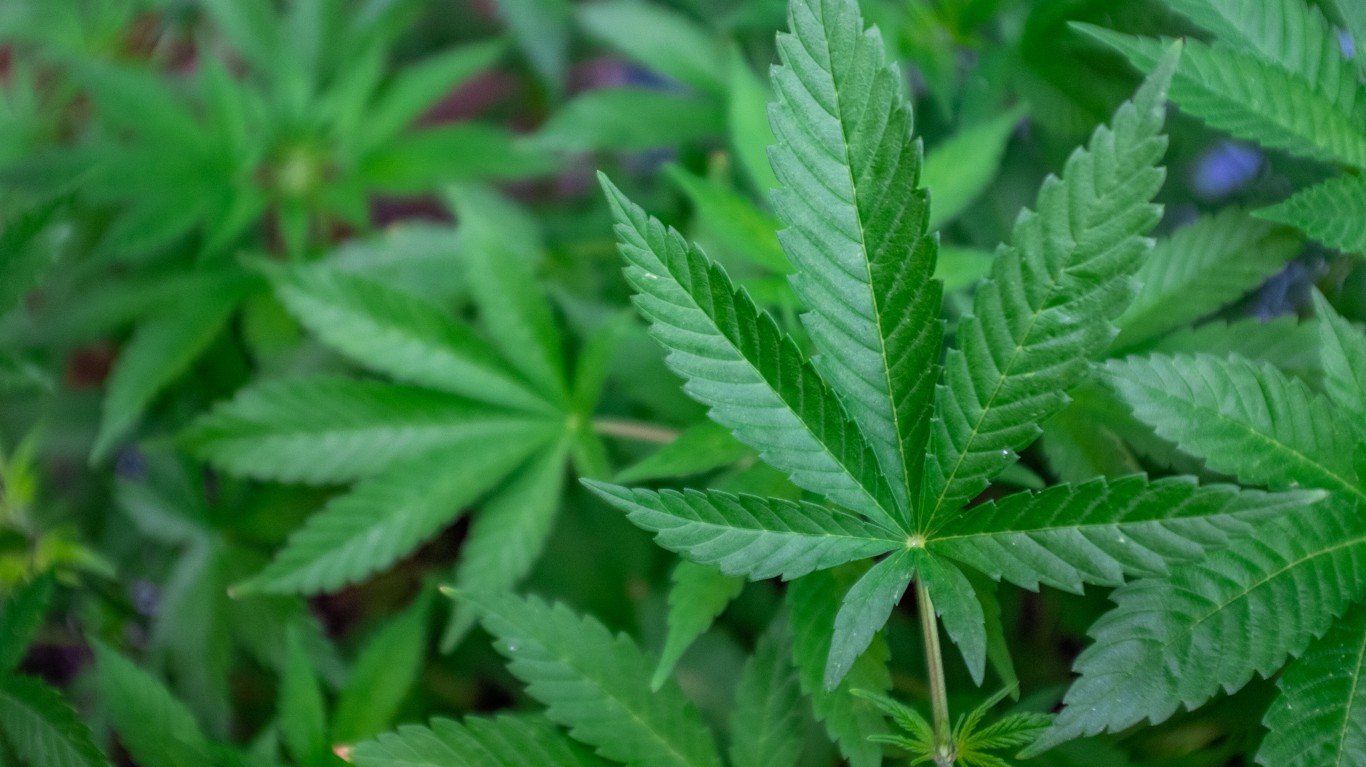
6. South Africa
> 2022 cannabis revenue: $678.1 million (+48.6% from ’21)
> 2021 cannabis revenue: $456.2 million
> 2021 population: 60,041,996
> 2021 GDP: $419.02 billion
> 2027 projected cannabis revenue: $1389.0 million (+104.8% from ’22)
Cannabis laws are pretty liberal in South Africa, where it has been decriminalized. A 2018 court ruling determined that prohibition of cannabis violated the right to privacy. This set in motion momentum to implement legal cannabis. A proposed Cannabis for Private Purposes Bill would allow adults to possess up to 600 grams of cannabis per person in private, 100 grams in public, and 1,200 grams per household. Cultivation of up to four plants per person would be permitted.
A 2017 amendment to the nation’s Medicines Act allows South Africans to buy and use cannabis for medical purposes.
5. Thailand
> 2022 cannabis revenue: $819.9 million (+48.6% from ’21)
> 2021 cannabis revenue: $551.6 million
> 2021 population: 69,950,844
> 2021 GDP: $505.95 billion
> 2027 projected cannabis revenue: $1680.0 million (+104.9% from ’22)
In June 2022, Thailand, which had some of the world’s strictest drug laws, removed marijuana and hemp from its Category 5 narcotics list, basically decriminalizing those substances, according to The Lonely Planet. The change in legislation allows Thais to grow and sell marijuana for medical use.
But there are certain considerations. Products for food or medicine must contain very low levels of tetrahydrocannabinol, or THC. Recreational use of marijuana, including smoking in public, is still not legal. Thai authorities are still working on draft legislation that regulates cannabis’ trade.
[in-text-ad]
4. Germany
> 2022 cannabis revenue: $873.8 million (+42.1% from ’21)
> 2021 cannabis revenue: $615.1 million
> 2021 population: 83,129,285
> 2021 GDP: $4.26 trillion
> 2027 projected cannabis revenue: $1877.0 million (+114.8% from ’22)
Germany legalized cannabis for medical purposes in 2017, one of the first EU nations to do so, and since then it has become a hub for patients all over Europe to get access to the substance. Cannabis in Germany is illegal for recreational use, though private possession of marijuana in what is termed a “small amount” is not always listed as an offense. This amount ranges from 6 grams to 10 grams in German states, and 15 grams in Berlin, according to Marijuana Times.
German federal drug law provides for imprisonment for up to five years for illegal possession and sale of cannabis. The offender can be sentenced to up to 15 years for selling marijuana to minors.
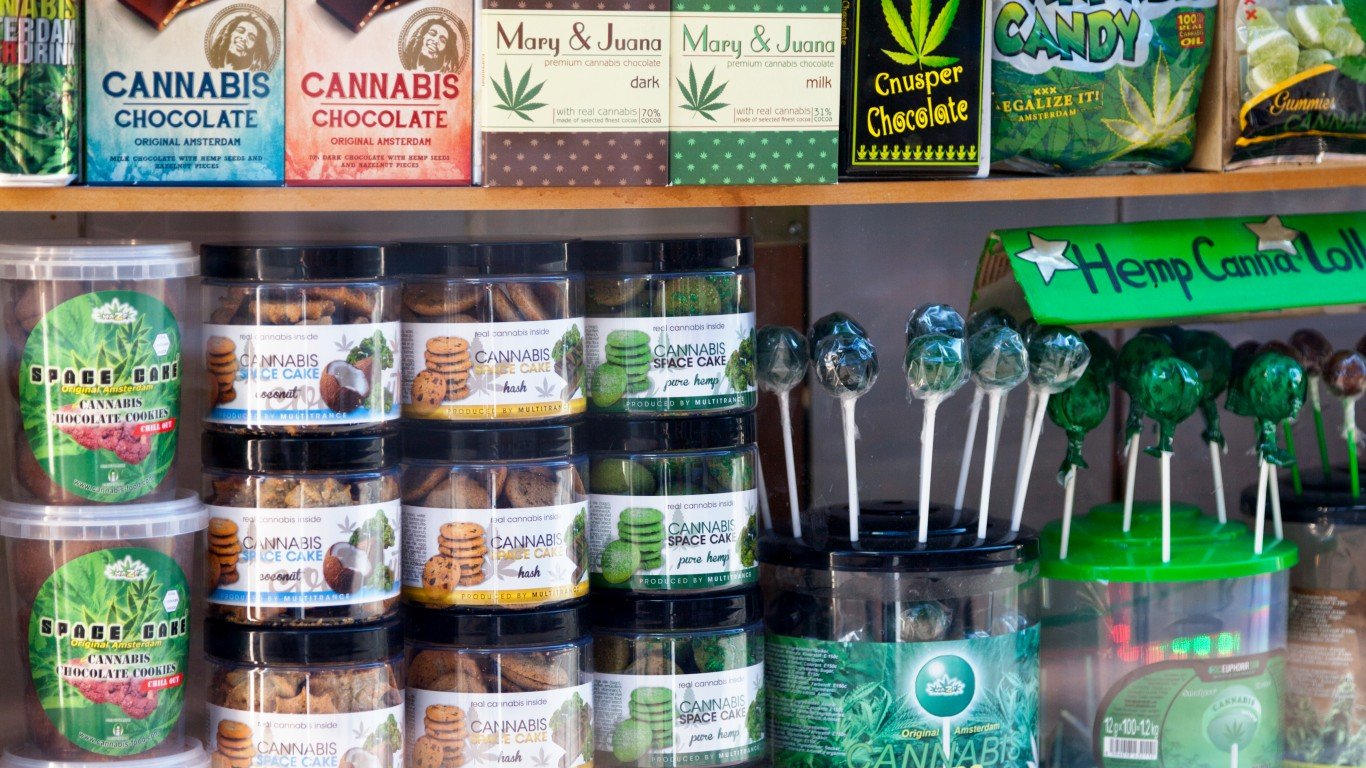
3. Netherlands
> 2022 cannabis revenue: $1.07 billion (+21.1% from ’21)
> 2021 cannabis revenue: $880.3 million
> 2021 population: 17,533,405
> 2021 GDP: $1.01 trillion
> 2027 projected cannabis revenue: $1.96 billion (+84.0% from ’22)
The popular image of the Netherlands, in particular Amsterdam, as a freewheeling location for cannabis use in coffee shops and on the street is somewhat at odds with reality. This is because selling marijuana in coffee shops, though tolerated if used on-site, is not legal under EU law. That has led to a black market for growing and distributing it, prompting a rise in organized crime.
Amsterdam is trying to change its image from a sex and drug center to a more high-end tourist destination. Related to that, the city has reduced the number of coffee houses in recent years. The Netherlands legalized medical cannabis in 2003.
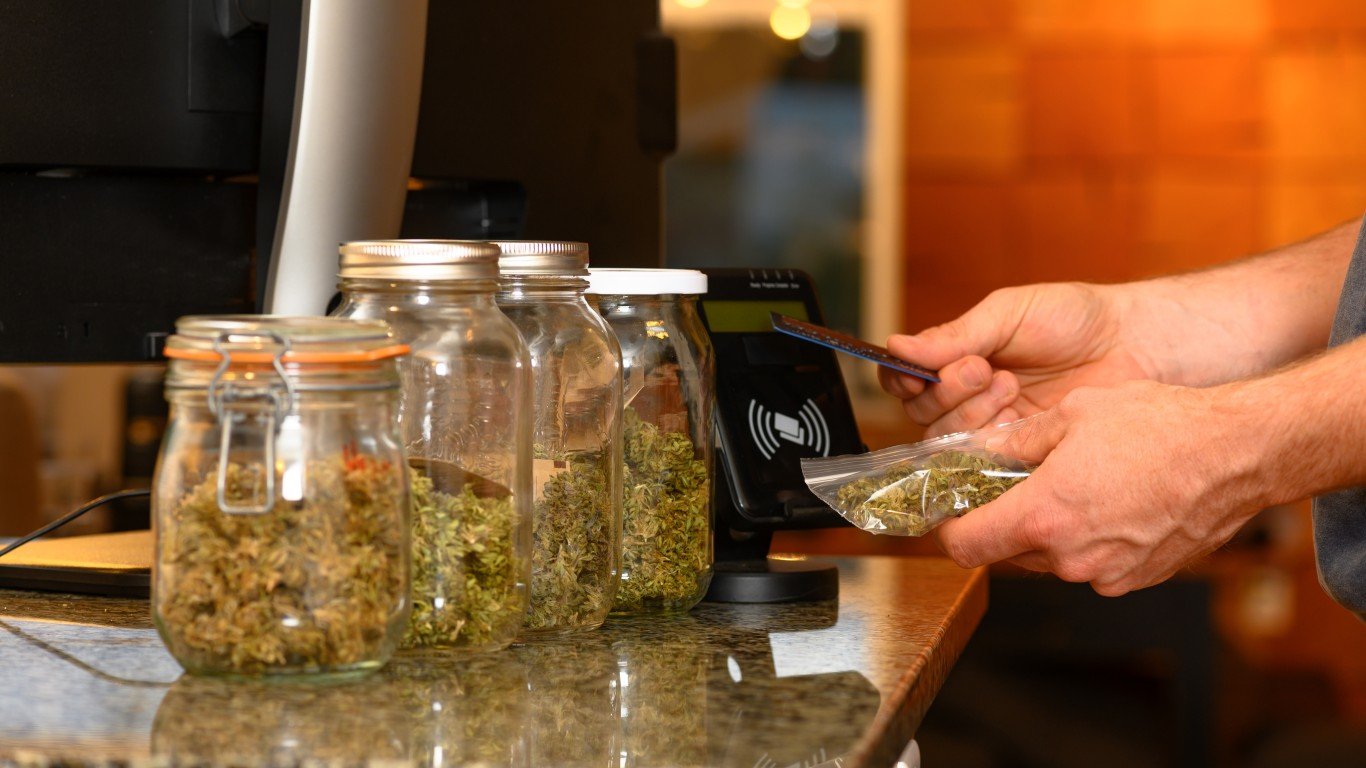
2. Canada
> 2022 cannabis revenue: $3.09 billion (+40.0% from ’21)
> 2021 cannabis revenue: $2.20 billion
> 2021 population: 38,246,108
> 2021 GDP: $1.99 trillion
> 2027 projected cannabis revenue: $6.39 billion (+107.0% from ’22)
In 2018, Canada became the second country in the world after Uruguay to legalize marijuana for recreational adult use. Medical cannabis has been legal since 2001. At $3.09 billion, Canada has the second-highest revenue from cannabis of any country in the world. The Cannabis Act was passed in part to reduce illicit activities related to the substance and ease the burden on the criminal justice system.
Canadian law permits an individual to buy, possess (up to 30 grams), or use cannabis and cannabis products if they are over 18, and grow up to four plants per residence for personal use. Licensed retailers can sell cannabis, including edible cannabis, cannabis extracts, and topicals. Possession, producing, or distributing cannabis outside of the legal boundary can result in a fine or jail time of up to 14 years.
[in-text-ad-2]
1. United States
> 2022 cannabis revenue: $27.90 billion (+21.8% from ’21)
> 2021 cannabis revenue: $22.91 billion
> 2021 population: 331,893,745
> 2021 GDP: $23.32 trillion
> 2027 projected cannabis revenue: $52.60 billion (+88.5% from ’22)
The United States, the most populous nation on the list, is by far the most robust market for cannabis consumption. The substance remains federally illegal. Federal law classifies marijuana as a Schedule I drug under the Controlled Substances Act. This means that the government does not recognize its medical use and considers it a substance of high risk for abuse. Possessing, growing, transporting, and distributing marijuana is a federal felony.
However, the U.S. government has chosen not to interfere with states that have legalized cannabis. A number of states have moved ahead with medical and recreational cannabis programs. A total of 41 states, as well the District of Columbia and Puerto Rico, have medical marijuana programs, while 23 have decriminalized cannabis.
Sponsored: Find a Qualified Financial Advisor
Finding a qualified financial advisor doesn’t have to be hard. SmartAsset’s free tool matches you with up to 3 fiduciary financial advisors in your area in 5 minutes. Each advisor has been vetted by SmartAsset and is held to a fiduciary standard to act in your best interests. If you’re ready to be matched with local advisors that can help you achieve your financial goals, get started now.
Thank you for reading! Have some feedback for us?
Contact the 24/7 Wall St. editorial team.
 24/7 Wall St.
24/7 Wall St.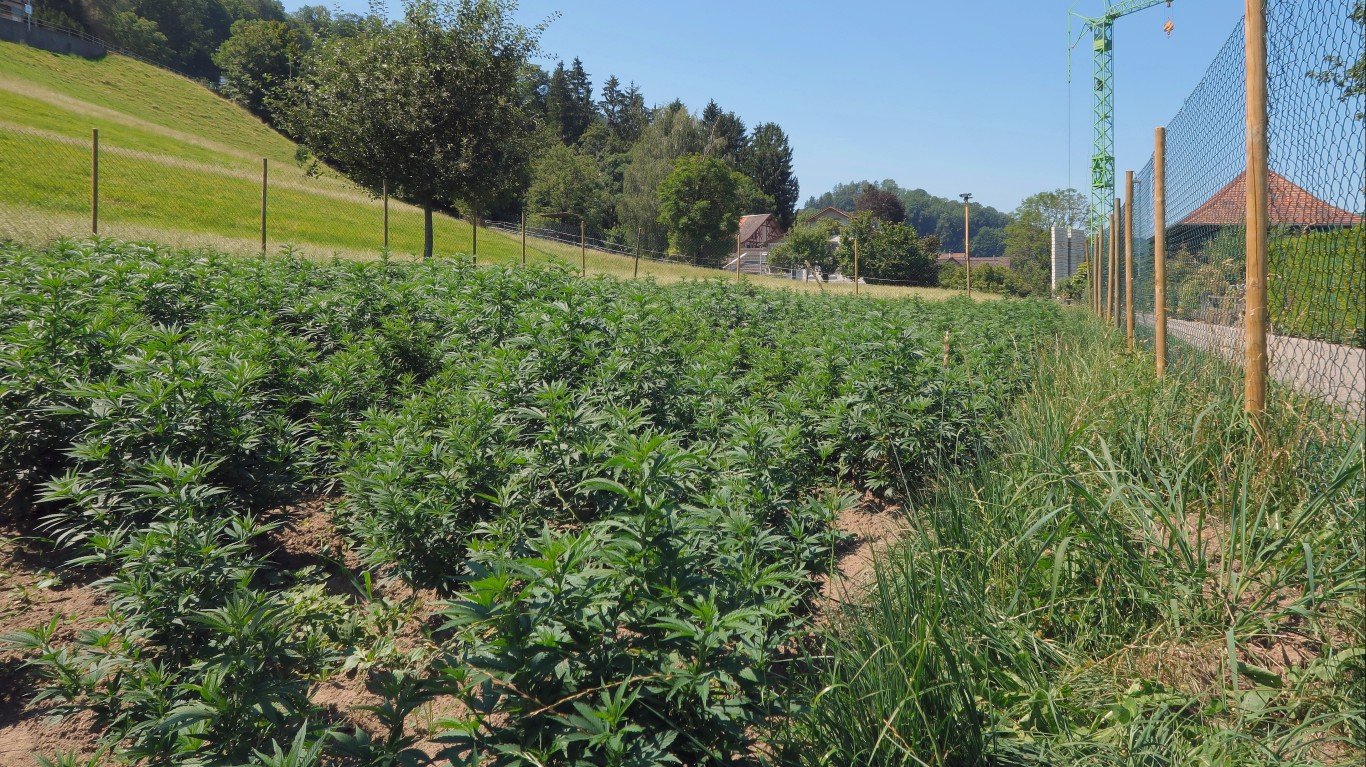
 24/7 Wall St.
24/7 Wall St.